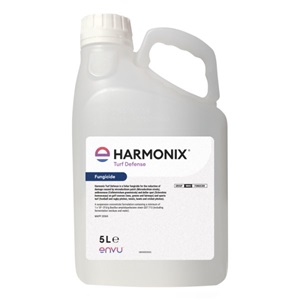A Changing Landscape: Greenkeeping and Sustainable Turf Management
Extreme weather is fast becoming the norm, with climate change producing the hottest summer months ever and the wettest winter since records began. For greenkeepers, weather is just one of the many challenges resulting from climate change, with regulatory updates and environmental awareness also dictating a shift in turf care practices across the board.
Gone are the days of quick-fix, one-stop turf solutions. Today the approach has to be more holistic; working with the environment, revising expectations, embracing innovation and reviewing practices. Caring for the planet now requires a mix of strategies to manage grass pests, weeds and disease as Phil Logan, Envu National Account Manager UK & Ireland, explains.
“Greenkeepers should proactively prepare for potential future regulatory changes despite the relaxation of EU regulations on pesticide use,” he says. “While an immediate ban on pesticides may not be imminent, it's crucial to acknowledge the gradual loss of active substances to stricter environmental conditions.”
Integrated Pest Management - the holistic approach
Integrated Pest Management (IPM) strategies combine various biological, cultural, physical, and chemical control methods to manage turf pests, weeds and diseases in an environmentally and economically sustainable way.
“By investing the time to review and integrate IPM practices into turf management plans, greenkeepers can enhance sustainability, minimise environmental impact, and maintain high-quality playing surfaces,” explains Phil.
IPM practices start from the ground up, with healthy soil and turfgrass selection central to a more holistic approach. Phil explains:
“Soil testing, effective aeration and organic matter management will help provide the best foundation for grass; improving nutrient availability and enhancing natural pest resistance. Balancing fertilisation and irrigation, while optimising pest monitoring techniques, will help ensure that controls are only used when necessary.”
Education and training are vital to keep greenkeepers at the forefront of sustainable options, securing the skillset needed to implement the best IPM strategies for each site and location. “Invest in time and training on topics such as pesticide application best practice, turfgrass biology, emerging pest and turf trends, and ecological principles,” Phil advises.
Greenkeepers can keep abreast of the latest innovations by fostering collaboration with their peers and by engaging with industry experts and organisations. “Exchanging best practices, research findings, and sharing innovative solutions with other turf care professionals will expand knowledge, as will attending industry conferences, workshops, and training sessions,” says Phil.
Legislation has enforced the withdrawal of many active substances, however, there is now much more choice of alternative solutions at the turf manager’s disposal. This is the start of a new era where new technologies are most effective and efficient when integrated into a comprehensive IPM strategy, Phil explains.
“Modern pesticides are still the most effective way to combat turf problems. Thanks to stricter environmental standards, they generally have a safer profile than those of the past, and they should still be utilised, as part of an effective IPM plan alongside other technologies,” he says.
New technologies can enhance both efficiency and effectiveness in turf care. Embracing options like climate-based disease models, data-driven decision-making, and smart irrigation systems, can optimise inputs, reduce waste, and minimise environmental impact.
Biological Controls - the way forward for turf
As the industry advances and environmental pressures necessitate the need to change, there is a thirst for knowledge that has created a better understanding of the life cycle of weeds, pests and diseases. This has helped to pinpoint the optimum time to deal with turf problems and has also led to the increased availability of biological controls that utilise the power of nature’s natural defences. For example: -
Predators and parasitoids can be used to control pest populations. For example, releasing ladybugs to control aphids or nematodes for leatherjacket/chafer grubs.
Microbial pesticides like some bacteria, fungi, or viruses can be used to specifically target plant pests or diseases.
Beneficial microorganisms, such as certain bacteria or fungi, can promote plant growth and suppress diseases, by establishing symbiotic relationships with plants to protect against pathogens.
Offering alternative ways to address weeds, pests and disease, biological controls are set to play an important part in IPM turf care strategies now, and in the future.
“As an R&D company, our focus at Envu is primarily on the development of sustainable solutions for turf grass management,” says Phil.
What the Future Holds for Greenkeepers
In our changing world, research and product development are delivering innovative, practical and sustainable options for turfcare, as Phil explains:
“Going forward greenkeepers can expect advancements in biocontrol products tailored to target specific turfgrass pests, while still minimising environmental impact. We’re also researching optimising application methods and formulations, to enhance the efficacy and longevity of conventional and biocontrol options in different turfgrass environments.
“Conventional pesticides remain an integral tool in sustainable turf management. We will continue to develop new formulations that reduce environmental impact, recognising their ongoing importance in pest management strategies and supporting the transition to reduce overall pesticide use.
“Ongoing research and innovation by Envu in biocontrols, modern pesticides, and new technologies will continue to drive advancements in sustainable turfgrass management,” Phil concludes.
Envu’s Bio-Control Fungicide - a UK First
Having brought the first bio-control fungicide to the UK, we can offer greenkeepers a practical and sustainable turf-care option. Harmonix® Turf Defense is a natural turf fungicide based on a unique strain of Bacillus amyloliquefaciens (QST 713). The product works on contact with the disease and by activating the plants natural defences.
During production, fungicidal lipopeptide compounds are produced by strain QST 713 and are present in the finished product for instant activity when ready to spray. On contact, these lipopeptides physically disrupt the cell membranes of the pathogen, resulting in the physical breakdown of its cells, which reduces the incidence of disease.
Harmonix® Turf Defense is a perfect addition to IPM strategies for the control of Microdochium Patch, Dollar Spot, and Anthracnose. Harmonix Turf Defense offers a versatile and effective solution against disease as part of a wider integrated approach.

